Organic Cheese Market Research, 2032
The global organic cheese market size was valued at $7.3 billion in 2022, and is projected to reach $16.3 billion by 2032, growing at a CAGR of 8.5% from 2023 to 2032. Organic cheese means it has been produced through organic farming methods. The source – dairy animals – have not been exposed to growth hormones and other chemicals that cause breast cancer and other ailments in humans. Other than, the animals used have not been treated with antibiotics. Organic cheese is often considered to be a healthier and more environmentally friendly option compared to conventionally produced cheese. Furthermore, conventionally produced cheeses are known to contain extra components from production and preservation. All these end up affecting the taste and quality, which is why organic cheese tastes better.
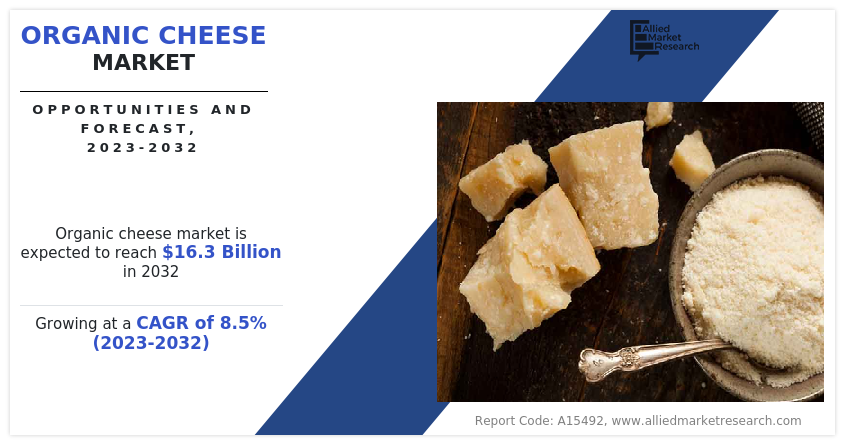
The organic cheese market demand is obsessive by the commitment of organic farming to the humane treatment of farm animals. Unlike conventional practices, organic dairy farmers prioritize the well-being of cows by avoiding the use of hormones or antibiotics to artificially boost milk production. Instead, they focus on maintaining the cows' good health through organic diets and providing them with access to fresh air, natural light, and open pasture. In case of illness, organic farmers use homeopathic medicines, whereas non-organic farms often administer antibiotics preventively, even when the cows are healthy. This excessive use of antibiotics not only reduces their effectiveness in combating diseases but also poses a potential risk to human health. Consumers appreciate the significance on animal welfare and responsible antibiotic usage in organic farming, which contributes to the increasing demand for organic cheese.
However, the production of organic cheese faces certain challenges. Organic cheese requires organic milk, which is sourced from organically raised cows. However, the availability of organic milk is limited due to the smaller number of organic dairy farms compared to conventional ones. As a result, organic cheese is often priced higher than conventional cheese, making it less accessible to price-sensitive consumers. Organic farmers also face higher production costs due to lower milk yields and the need to purchase supplementary feed. Additionally, the lack of energy feeds in organic farming and the difficulties in growing energy feed crops like corn under organic conditions further contribute to the higher prices of organic cheese. Organic farmers also receive lower milk prices compared to non-organic farmers, which poses a challenge for the organic cheese industry. Furthermore, the competition from readily available and lower-priced conventional cheese adds to the market constraints for organic cheese.
Despite these challenges, the worldwide demand for organic cheese is steadily increasing due to factors such as population growth, higher consumption per person, the growth of gym culture, on-the-go eating solutions, increased food consumption outside the home, and the rise of online and mobile shopping. Organic cheese aligns with these trends as a convenient and protein-rich option. As incomes rise and urbanization increases, individuals tend to shift their calorie intake towards proteins, including cheese, rather than relying heavily on basic carbohydrates. These factors contribute to the larger consumer base for organic cheese products.
While competition authorities typically address concerns related to competition in the food industry, the organic cheese market presents additional complexities that require attention. The competition between organic and conventional cheese is influenced by factors such as price sensitivity and consumer preferences for affordability over organic certification. These factors collectively impact the organic cheese market growth.
Segmental Overview
The organic cheese market forecast is analysed on the basis of type, distribution channel, form and region. By type, the market is divided into Cheddar, Mozzarella, Swiss, Parmesan, Feta, Others. By distribution channel, the market is segmented into Retail Distribution, Food Service Outlets, Food Processing Companies, Clubs. Depending on forms, it is classified into Slices, Blocks, Cubes, Spreads, Others. Region-wise, the market is analysed across North America (the U.S., Canada, and Mexico), Europe (the UK, Germany, France, Russia, Italy, Spain, and the rest of Europe), Asia-Pacific (China, Japan, India, South Korea, Australia & New Zealand, South Korea, ASEAN, and the rest of Asia-Pacific), and LAMEA (Brazil, South Africa, Turkey, Saudi Arabia, and the rest of LAMEA).
By Type
Based on type, the market is classified into Cheddar, Mozzarella, Swiss, Parmesan, Feta, Others. The Cheddar segment accounted for a major organic cheese market share in 2022 and is expected to grow at a significant CAGR during the forecast period. Demand for organic cheese is increasing due to growing consumer awareness and health concerns. Consumers are increasingly aware of the environmental and health benefits of organic cheese, which is driving demand for these products. Hence, these factors are fuelling the cheddar segment in the organic cheese market.
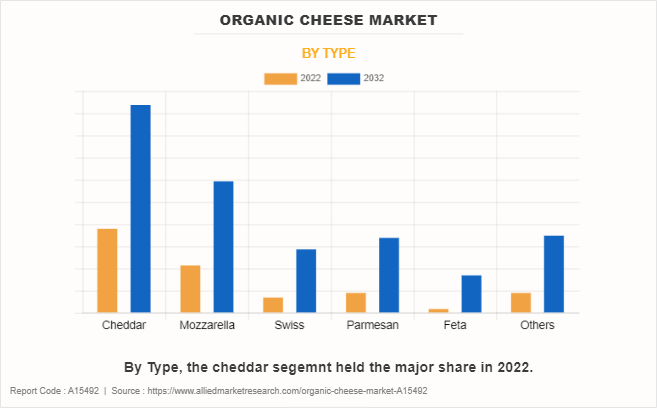
By Form
By form, the market is classified into slices, blocks, cubes, spreads, others. The blocks segment is predicted to show the fastest growth in the global cheese market during the forecast period. Cheese blocks offer convenience in terms of storage and usage. They are typically larger in size and can be easily stored in the refrigerator. Cheese blocks can be sliced, grated, or cubed according to individual preferences, making them versatile for various recipes and snacking options. The larger size and protective packaging of cheese blocks help to preserve the cheese for a longer period, reducing the risk of spoilage. This makes them a preferred choice for consumers who want to have cheese on hand for longer durations.
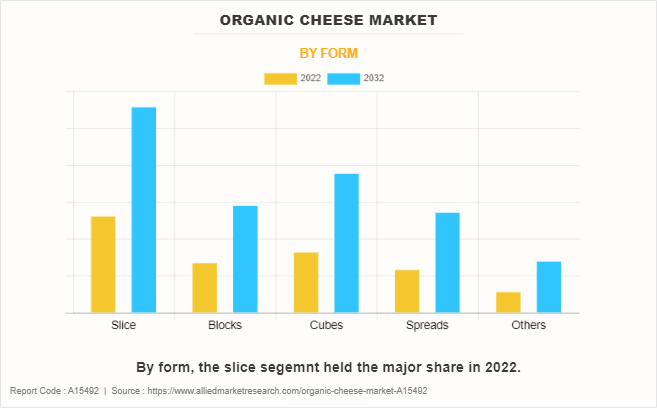
By Distibution Channel
By distribution channel, the market is classified into retail distribution, food service outlets, food processing companies, clubs. The retail distribution segment is predicted to show the fastest growth in the global cheese market during the forecast period. The organic cheese market has seen an increase in the influence of retail distribution channels. The development of e-commerce platforms, the emergence of direct-to-consumer (DTC) companies, and improved personalization made possible by AI and AR technology are the key developments. DTC brands provide a direct and smooth buying experience, encouraging customer loyalty and brand trust. Customers' online purchasing experiences are improved by AI and AR solutions that enable virtual product trials. In addition, e-commerce sites such as Big-Basket and Blinkit give both well-known and up-and-coming businesses a platform to connect with a global clientele. As a result, the distribution model for organic cheese is changing to become more digital and customer-focused.
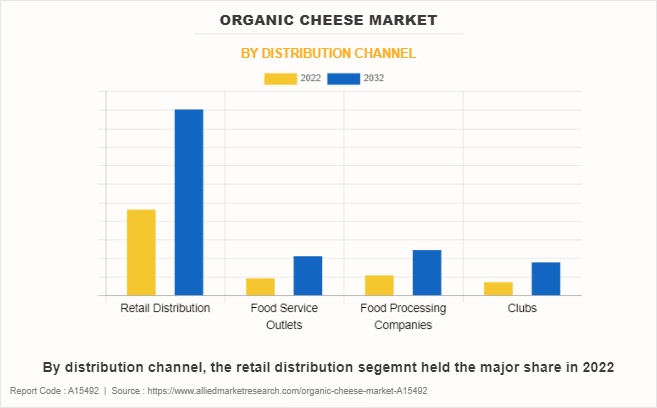
By Region
Region wise, it is analysed across North America, Europe, Asia-Pacific, and LAMEA. The North America & Europe organic cheese market is accounted for a major share in 2022 and is expected to grow at a significant CAGR during the forecast period. The demand for organic cheese in North America & Europe is rising as the rise of healthy lifestyle, growing health concerns, production, e-commerce and online grocery shopping, which has made it easier for consumers to access a wider range of organic cheese.
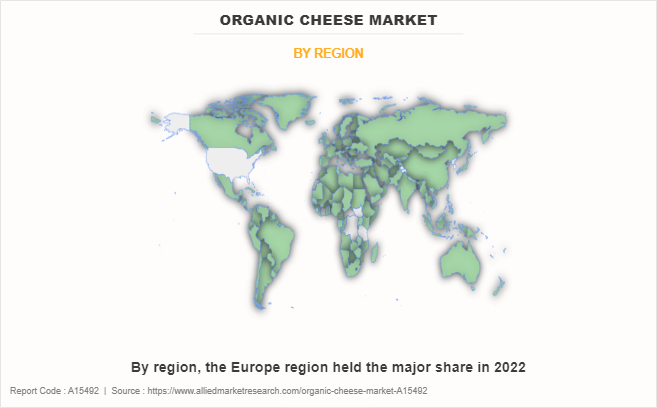
Competitive Landscape
The major players operating in the market focus on key market strategies, such as mergers, product launches, acquisitions, collaborations, and partnerships. They have been also focusing on strengthening their market reach to maintain their goodwill in the ever-competitive market. Some of the key players in the organic cheese market include Kerry Group plc, Groupe Lactalis S.A, Unilever N.V., Fonterra Co-operative Group Limited, Organic Valley, The Kroger Co., Arla Foods, Ornua, Danone, Eden Valley Creamery, Hormel Foods
Key Benefits for Stakeholders
- This report provides a quantitative analysis of the market segments, current trends, estimations, and dynamics of the organic cheese market analysis from 2022 to 2032 to identify the prevailing organic cheese market opportunities.
- The market research is offered along with information related to key drivers, restraints, and opportunities.
- Porter's five forces analysis highlights the potency of buyers and suppliers to enable stakeholders make profit-oriented business decisions and strengthen their supplier-buyer network.
- In-depth analysis of the organic cheese market segmentation assists to determine the prevailing market opportunities.
- Major countries in each region are mapped according to their revenue contribution to the global market.
- Market player positioning facilitates benchmarking and provides a clear understanding of the present position of the market players.
- The report includes the analysis of the regional as well as global organic cheese market trends, key players, market segments, application areas, and market growth strategies.
Organic Cheese Market Report Highlights
| Aspects | Details |
| Market Size By 2032 | USD 16.3 billion |
| Growth Rate | CAGR of 8.5% |
| Forecast period | 2022 - 2032 |
| Report Pages | 444 |
| By Type |
|
| By Form |
|
| By Distribution Channel |
|
| By Region |
|
| Key Market Players | Hormel Foods, Danone, Groupe Lactalis S.A, The Kroger Co., Fonterra Co-operative Group Limited, Arla Foods, Ornua, Organic Valley, Unilever N.V., Kerry Group plc, Eden Valley Creamery |
Analyst Review
According to the insights of the CXOs, the global organic cheese market is expected to witness robust growth during the forecast period. This is attributed to the growing demand for sustainable and healthy organic cheese products. Growing demand for healthy and sustainable products is expanding the organic cheese market. As consumers become more aware of the health benefit, they are increasingly looking for products that support health & nutritional benefit. As a result, demand for products made from organic cheese is increasing. Furthermore, to attract consumers around the globe, key players in the market are investing in R&D activities and advertising & promotion of products.
CXOs further added about rising demand for sustainable cheese is further creating opportunities in the organic cheese market. In response to the growing emphasis on gut health, more customers are turning to probiotic-rich dairy products such as cheese. These cheese products have gained popularity because of their ability to improve digestion and general intestinal health. Furthermore, consumers wanting a better vitamin, protein, and mineral intake are considering cheese consumption, particularly organic cheese. Organic Cheese is thought to play an important role in strengthening the immune system and protecting against a variety of health issues, including cancer, stroke, and type 2 diabetes
The global organic cheese market size was valued at $7.3 billion in 2022, and is projected to reach $16.3 billion by 2032
The global Organic Cheese market is projected to grow at a compound annual growth rate of 8.5% from 2023 to 2032 $16.3 billion by 2032
Some of the key players in the organic cheese market include Kerry Group plc, Groupe Lactalis S.A, Unilever N.V., Fonterra Co-operative Group Limited, Organic Valley, The Kroger Co., Arla Foods, Ornua, Danone, Eden Valley Creamery, Hormel Foods
The North America & Europe organic cheese market is accounted for a major share in 2022 and is expected to grow at a significant CAGR during the forecast period.
Inclination of consumers toward a healthy diet pattern, Growing health concern about animal health problems in dairy sector, Demand for on-the-go eating solutions
Loading Table Of Content...
Loading Research Methodology...



